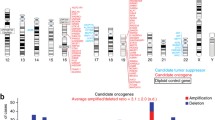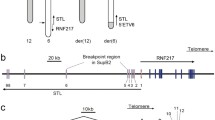Abstract.
KET is a member of the newly discovered family of proteins that is related to the tumor suppressor p53. Here we describe the molecular cloning of a human cDNA of 4846 bp encoding a protein of 680 amino acids. The human KET protein shares 98% identity with the previously characterized rat homolog. The remarkably high degree of conservation lends support to the notion that KET proteins have important basic functions in development and differentiation. Using the GeneBridge 4 radiation hybrid panel, we have mapped KET to human Chromosome (Chr) 3q27. KET is located between the somatostatin gene SST (proximal) and the apolipoprotein D gene APOD (distal) in a region of conserved synteny to mouse Chr 16. This chromosomal region is deleted in early stages of tumorigenesis of mouse islet cell carcinomas and contains the hitherto unidentified Loh2 gene, a putative suppressor of angiogenesis. The murine homolog Ket was mapped in an interspecific backcross panel and falls into this region of loss of heterozygosity. From our mapping data we infer that KET might act as a tumor suppressor and is considered as a candidate for Loh2.
Similar content being viewed by others
Author information
Authors and Affiliations
Additional information
Received: 30 April 1998 / Accepted: 17 July 1998
Rights and permissions
About this article
Cite this article
Augustin, M., Bamberger, C., Paul, D. et al. Cloning and chromosomal mapping of the human p53-related KET gene to Chromosome 3q27 and its murine homolog Ket to mouse Chromosome 16. 9, 899–902 (1998). https://doi.org/10.1007/s003359900891
Issue Date:
DOI: https://doi.org/10.1007/s003359900891




